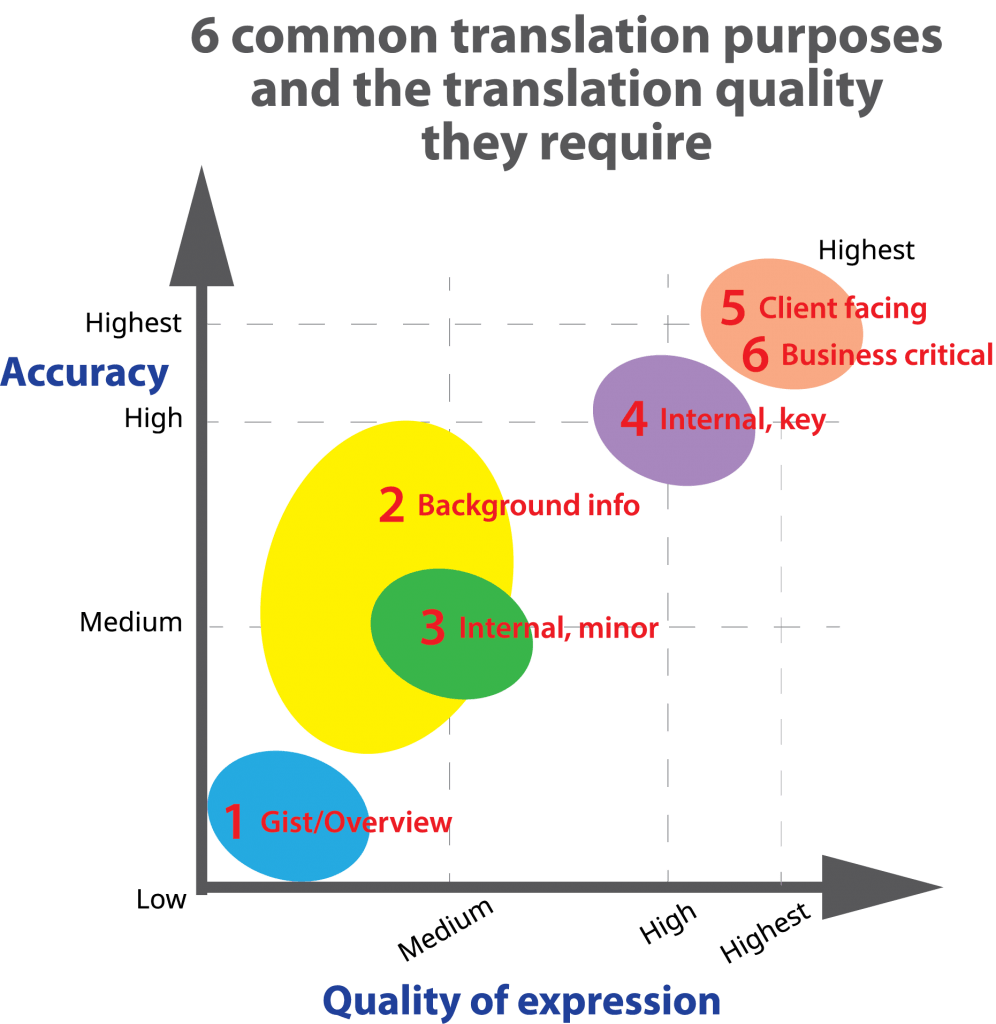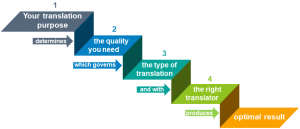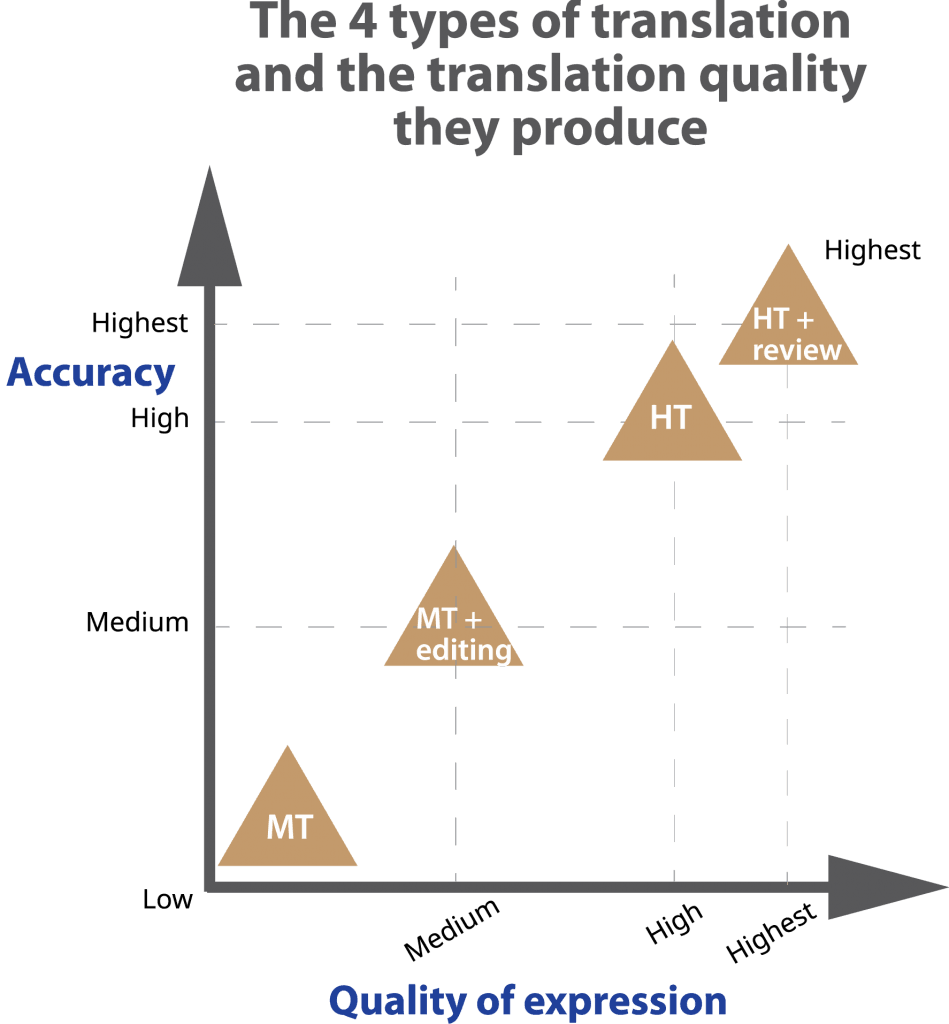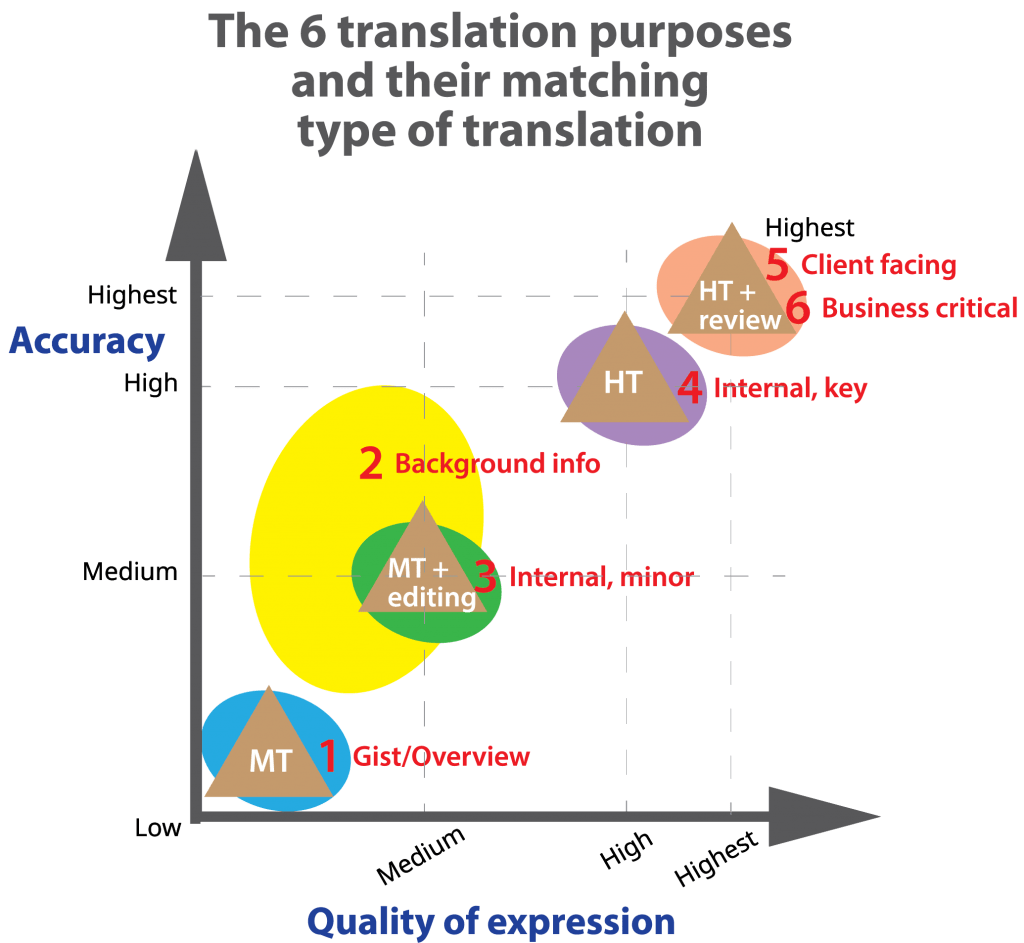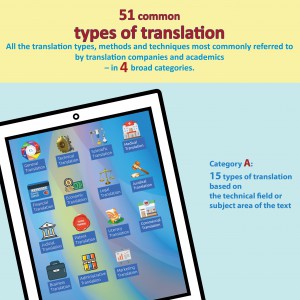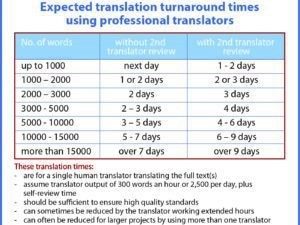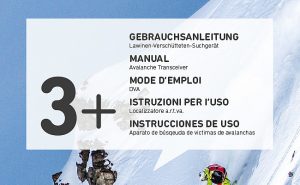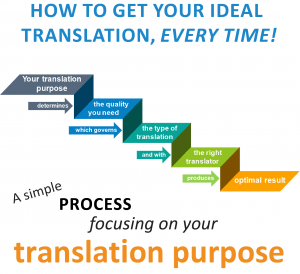
This article identifies the 6 most common purposes for translations in business.
And the surprising differences in translation quality they require.
We then give you a simple 3-step method to always ensure you get the quality of translation your purpose requires.
What is translation purpose?
Your translation purpose is what you’ll use a translation for, or the function it will serve.
The 6 main translation purposes in business, and why they’re so different
1. Gist/overview
What is it?
This purpose is where you just want to know broadly what the text is about or says.
You want to know the subject matter and the main message, but the detail doesn’t matter.
Examples
- a report you’re not sure is going to be relevant
- a mention of your company/product/service online or in the media
Translation quality needed
Here we’re focusing on the two main aspects to translation quality – accuracy of meaning and quality of expression.
We’re basically weighing up how important a difference in meaning or some unnatural or clunky wording in the translation would be.
For this purpose you certainly don’t need a perfect translation.
A “rough”, “preliminary” or “gist translation” should meet your needs – you can always upgrade to better quality later if needed.
Accuracy: A few mistranslations or inaccuracies in the translation shouldn’t stop you understanding the main message.
Expression: Some unnatural or awkward wording also shouldn’t stop you understanding what the document is about.
2. Background info
What is it?
Documents you read to keep abreast of developments or for basic info on a subject.
Many you’ll read just once and discard.
Others you might want to revisit later so will archive.
And some you’ll want to keep as reference materials.
Examples
- a report on the economy or state of your market
- a business case
- a product review
Translation quality needed
Accuracy: You’ll want to be sure you’re getting the right message and correct information, so a good degree of accuracy is important.
That said, the odd translation mistake won’t generally be critical for this purpose.
Expression: Good wording isn’t so important. The translation needs to be readily understandable but doesn’t need to read beautifully.
3. Internal documents of lesser importance
What is it?
Documents used solely within your organisation where a shortcoming in the translation wouldn’t be a big problem.
Examples
- internal memos/updates
- e-mail threads
Translation quality needed
Accuracy: Reasonable, to ensure the correct message is conveyed, but the odd mistake can presumably be tolerated.
Expression: As long as the message is clear, some less polished wording shouldn’t matter.
4. Key internal documents
What is it?
Documents for internal circulation where a shortcoming in the translation would potentially be a big deal.
Examples
- operations manuals
- health and safety instructions
- policy documents
Translation quality needed
Accuracy: You can’t run the risk of things being misunderstood, so you need high accuracy.
Expression: You also don’t want any ambiguities or lack of clarity, so the translation needs to be well-worded throughout.
5. Client-facing materials
What is it?
All client, supplier and public domain materials, plus all correspondence/dealings with anyone outside your organisation.
The key thing here is that your reputation is always on the line with the translation of these documents.
Some materials will also carry financial risk for you.
Examples
- marketing materials
- product manuals
- social media / blog posts
Translation quality needed
Accuracy: You can’t afford a mistake in these documents, so need the highest level of accuracy.
Expression: And you need excellent wording – you don’t want your reputation tarnished by unnatural wording in a translation.
6. Business-critical materials
What is it?
Documents essential to your organisation operating successfully.
Examples
- sales and supplier contracts
- regulatory filings
- financial accounts
Translation quality needed
Accuracy: For this purpose a mistake could be momentous, so nothing short of the highest level of accuracy will do.
Expression: You need 100% excellent, clear wording throughout – there’s no place for ambiguity or unclear wording in these translations.
Summary of the translation quality the 6 main translation purposes require
| Translation purpose/use | Accuracy | Expression |
|---|---|---|
| 1. Gist/Overview | Low | Low |
| 2. Background info | Medium - high | Low - medium |
| 3. Internal, minor docs | Medium | Medium |
| 4. Internal, key docs | High | High |
| 5. Client facing | Highest | Highest |
| 6. Business critical | Highest | Highest |
And we can chart this:
We need to stress that these are the minimum quality levels acceptable for each translation purpose/function.
You may well want better – especially if you could use the translation for a different purpose later. A higher quality translation will always serve your purpose and will generally do the job better.
Some clients always opt for higher quality translations, regardless of purpose. They figure they’d rather be safe than sorry.
But there are two reasons most clients don’t – time and cost.
Generally, the higher the quality:
- the more expensive the translation
- the longer a translation will take
Most of us don’t like paying more than we need to, and there’ll be times when you need a quicker turnaround.
How to get your ideal translation for each purpose – in 3 simple steps
Here’s a graphic of the process:
Step 1: Understand the translation quality your purpose requires
Identify your purpose from our list and our assessment of how accurate and well-worded the translation needs to be in the table and chart above.
Make sure you agree!
If you don’t, decide for yourself the translation quality you need.
Keep this in mind as you’ll use it in the next step.
Step 2: Match the required quality to the right type of translation
There are 4 main types of translation used in business – which we explain in some detail in our separate article, video and infographic.
These are:
- Machine Translation (MT) – translation by a computer program or app such as Google Translate, with no human involvement
- Machine Translation + editing – the machine translation is edited by a human to fix errors and unclear wording
- Human translation (HT) – translation by a professional human translator following best practice processes
- Human translation plus review – a second translator reviews the human translation as a safety check and to further refine wording
These typically achieve the following levels of translation quality:
| Type | Accuracy | Expression |
|---|---|---|
| 1. MT | Low – likely to contain translation errors, misinterpretations, incorrect vocabulary usage | Low – some parts OK, others unclear, some gibberish |
| 2. MT + editing | Medium – most problems will be fixed but any that aren’t obvious will remain | Medium – the text is made understandable without being “polished” into elegant prose |
| 3. HT | High – but there’s always the chance of inadvertent “human error” | High – will read well with good quality of expression |
| 4. HT + review | Highest – any “human errors” will be picked up | Highest – the translation will be further refined to improve quality of expression |
Or visually:
Important: The human translators we’re referring to here are proven professionals.
They’re qualified, experienced, have the skillset required for professional translation and stick like glue to best practice translation processes.
They’re the type of translator we engage for our work.
Not all translators meet these standards, so selecting the right translator for your project is crucial to achieving these outcomes.
Overlaying this chart with the earlier one gives a rather neat correlation between our 6 translation purposes and 4 translation methods:
Which identifies the type of translation most suitable for each translation purpose:
| Translation purpose/function | Suitable Type of Translation |
|---|---|
| 1. Gist/Overview | Machine Translation |
| 2. Background info | Human Translation |
| 3. Internal, minor docs | Machine Translation + editing |
| 4. Internal, key docs | Human Translation |
| 5. Client facing | Human Translation + review |
| 6. Business critical | Human Translation + review |
Important: Again we must stress that these correlations generate the minimum acceptable translation standard required, and higher quality will always serve your needs better.
Note: For purpose number 2 (texts for background information), a human translator rather than machine translation plus editing is needed to achieve the greater accuracy needed.
Why do this? – the 2 key advantages of matching translation purpose and type
The 4 types of translation don’t just vary considerably in quality, they also have very different cost and turnaround times.
We can plot this like this:
So matching your translation purpose with a suitable type of translation doesn’t only give you your required translation quality.
You also pay the most economical price and get the fastest turnaround time for the quality level you need.
Step 3: Choose the right provider – the final step to getting the translation you need
Choosing the right translator is obviously central to getting a translation of the quality you need for your purpose.
Here are our tips for doing that.
Machine translation
Use Google Translate. If a passage doesn’t make sense, try it in Microsoft Translator – it might be clearer.
BUT, be sure you understand the limitations of machine translation programs!
Machine Translation + editing
Search out a translation company that offers this service – sorry, we don’t. They may refer to it as PEMT – post-editing machine translation.
A company experienced in PEMT will know which of their translators to use (many won’t do these jobs, and others aren’t so good at it), and they’ll have their processes down pat.
Alternatively, you could source a translator yourself, but that might be a bit of a lottery. You’d want someone with solid experience doing this sort of work.
Human Translation
Use our budget professional translation service – our translators are top notch and you’ll get the quality you need.
Alternatively, use another translation company – but make sure they’re genuinely quality focused. Perhaps compare what they offer with the steps we take to ensure consistently high standards.
Or you could source a translator yourself. If considering this, we suggest you read our articles on the skills translators need and the translation process professional translators use. They’ll help you know what to look for.
Human Translation + review
Use our quality-assured translation service – it’s designed precisely for this scenario and will give you the very best translation standard.
Alternatively, you could choose another company – just make sure they’re genuinely quality-focused and follow best practice.
Most individual translators don’t have their work independently peer-reviewed, so translation companies are generally best for this.
Conclusion
This process is all about value for money.
It’s a way of focusing on your translation purpose to get exactly the translation you need.
It will deliver a high-quality translation when you need it.
And one of lesser quality when that will serve your purpose.
This gives you the most economical translation for your needs, in the most favourable time frame.
Like a summary of this article?
Let us quote for your next translation project.
We know our stuff and will deliver you high-quality work!
Just:
– use our translation quote form, or
– e-mail us the details
and we’ll be right back to you.
Make sure you’re getting our Translation Tips e-mails!
Proven, highly practical and quick-read tips for achieving better translation results, direct to your inbox.
Great value for just 20 seconds of your time, once a fortnight. Sign up now, or read more here.
See the Key articles for clients list on our main blog page.
Or you could start with these:
The ultimate list of 51 different types of translation – and what they all mean
Realistic translation times – knowing how long a translation will take
Knowing when you need a technical translator – and when you don’t

